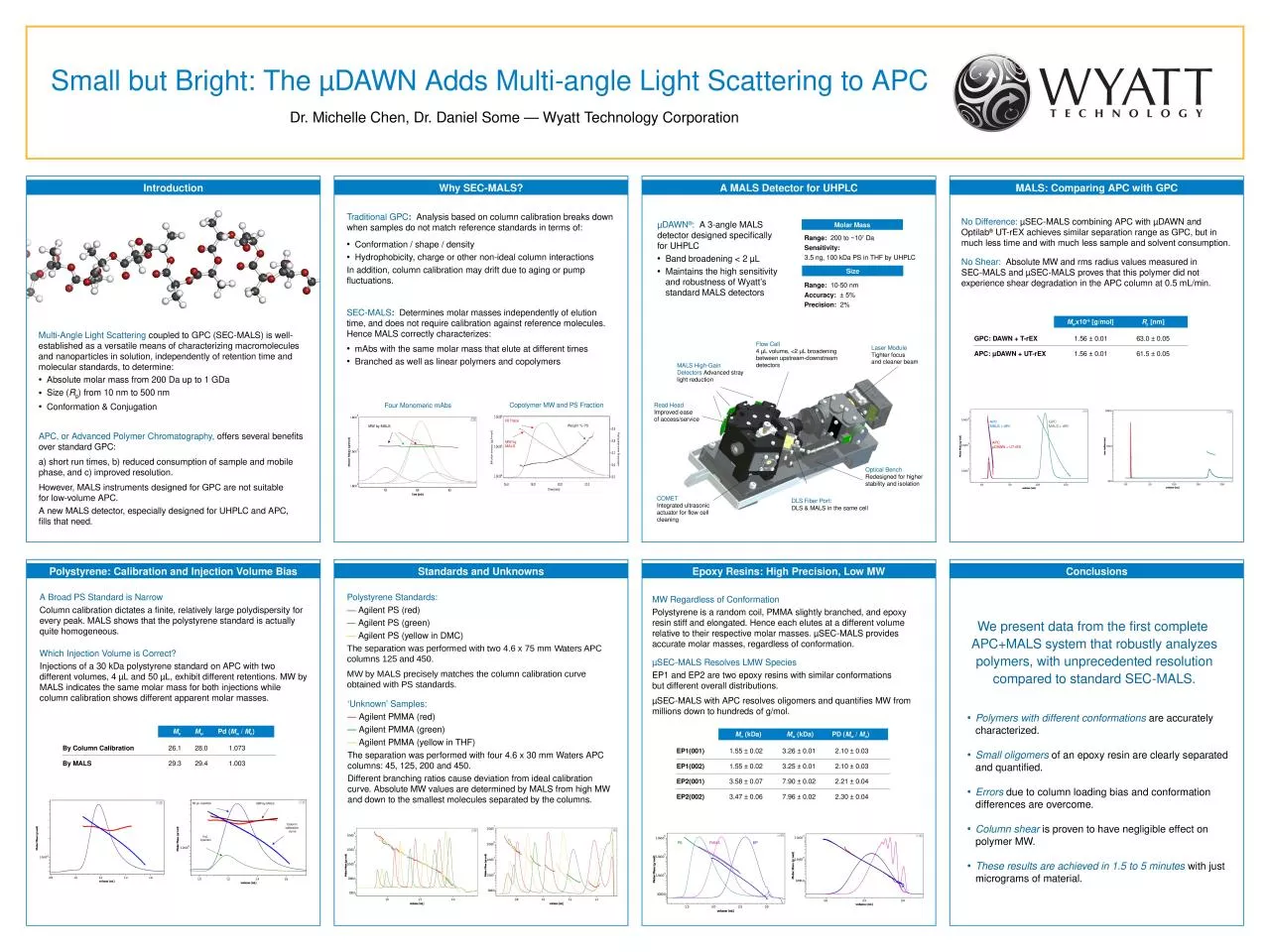/


156 001 630 005 APC µDAWN UTrEX 156 001 615 005 Small but Bright The µDAWN Adds Multiangle Light Scattering to APC Dr Michelle Chen Dr ID: 1037148
Download Presentation The PPT/PDF document "GPC: DAWN + T-rEX" is the property of its rightful owner. Permission is granted to download and print the materials on this web site for personal, non-commercial use only, and to display it on your personal computer provided you do not modify the materials and that you retain all copyright notices contained in the materials. By downloading content from our website, you accept the terms of this agreement.
1. GPC: DAWN + T-rEX 1.56 ± 0.01 63.0 ± 0.05APC: µDAWN + UT-rEX 1.56 ± 0.01 61.5 ± 0.05Small but Bright: The µDAWN Adds Multi-angle Light Scattering to APCDr. Michelle Chen, Dr. Daniel Some — Wyatt Technology Corporation IntroductionMulti-Angle Light Scattering coupled to GPC (SEC-MALS) is well-established as a versatile means of characterizing macromolecules and nanoparticles in solution, independently of retention time and molecular standards, to determine:Absolute molar mass from 200 Da up to 1 GDaSize (Rg) from 10 nm to 500 nmConformation & ConjugationTraditional GPC: Analysis based on column calibration breaks down when samples do not match reference standards in terms of:Conformation / shape / densityHydrophobicity, charge or other non-ideal column interactionsIn addition, column calibration may drift due to aging or pump fluctuations.µDAWN®: A 3-angle MALS detector designed specifically for UHPLCBand broadening < 2 µLMaintains the high sensitivity and robustness of Wyatt’s standard MALS detectorsCopolymer MW and PS FractionMW by MALSWeight % PSRI TraceFour Monomeric mAbsMW by MALSRange: 200 to ~107 DaSensitivity: 3.5 ng, 100 kDa PS in THF by UHPLCRange: 10-50 nmAccuracy: ± 5%Precision: 2%MALS High-Gain Detectors Advanced stray light reductionFlow Cell 4 µL volume, <2 µL broadening between upstream-downstream detectorsLaser Module Tighter focus and cleaner beam COMETIntegrated ultrasonic actuator for flow cell cleaningDLS Fiber Port:DLS & MALS in the same cellRead HeadImproved ease of access/serviceOptical BenchRedesigned for higher stability and isolationAPCMALS + dRIGPCMALS + dRIAPCµDAWN + UT-rEXNo Difference: µSEC-MALS combining APC with µDAWN and Optilab® UT-rEX achieves similar separation range as GPC, but in much less time and with much less sample and solvent consumption.No Shear: Absolute MW and rms radius values measured in SEC-MALS and µSEC-MALS proves that this polymer did not experience shear degradation in the APC column at 0.5 mL/min.Polymers with different conformations are accurately characterized.Small oligomers of an epoxy resin are clearly separated and quantified.Errors due to column loading bias and conformation differences are overcome.Column shear is proven to have negligible effect on polymer MW.These results are achieved in 1.5 to 5 minutes with just micrograms of material.4 µL injection50 µL injectionColumn calibration curveMW by MALSA Broad PS Standard is NarrowColumn calibration dictates a finite, relatively large polydispersity for every peak. MALS shows that the polystyrene standard is actually quite homogeneous.Which Injection Volume is Correct?Injections of a 30 kDa polystyrene standard on APC with two different volumes, 4 µL and 50 µL, exhibit different retentions. MW by MALS indicates the same molar mass for both injections while column calibration shows different apparent molar masses.Polystyrene Standards: — Agilent PS (red)— Agilent PS (green)— Agilent PS (yellow in DMC)The separation was performed with two 4.6 x 75 mm Waters APC columns 125 and 450. MW by MALS precisely matches the column calibration curve obtained with PS standards.‘Unknown’ Samples: — Agilent PMMA (red)— Agilent PMMA (green)— Agilent PMMA (yellow in THF)The separation was performed with four 4.6 x 30 mm Waters APC columns: 45, 125, 200 and 450. Different branching ratios cause deviation from ideal calibration curve. Absolute MW values are determined by MALS from high MW and down to the smallest molecules separated by the columns. EPPMMAPSMW Regardless of ConformationPolystyrene is a random coil, PMMA slightly branched, and epoxy resin stiff and elongated. Hence each elutes at a different volume relative to their respective molar masses. µSEC-MALS provides accurate molar masses, regardless of conformation.µSEC-MALS Resolves LMW SpeciesEP1 and EP2 are two epoxy resins with similar conformations but different overall distributions. µSEC-MALS with APC resolves oligomers and quantifies MW from millions down to hundreds of g/mol.We present data from the first complete APC+MALS system that robustly analyzes polymers, with unprecedented resolution compared to standard SEC-MALS.SEC-MALS: Determines molar masses independently of elution time, and does not require calibration against reference molecules. Hence MALS correctly characterizes:mAbs with the same molar mass that elute at different times Branched as well as linear polymers and copolymersAPC, or Advanced Polymer Chromatography, offers several benefits over standard GPC: a) short run times, b) reduced consumption of sample and mobile phase, and c) improved resolution. However, MALS instruments designed for GPC are not suitable for low-volume APC. A new MALS detector, especially designed for UHPLC and APC, fills that need.Why SEC-MALS?A MALS Detector for UHPLCMALS: Comparing APC with GPCMolar MassSize Mwx10-6 [g/mol] Rz [nm]Polystyrene: Calibration and Injection Volume BiasBy Column Calibration 26.1 28.0 1.073By MALS 29.3 29.4 1.003 Mn Mw Pd (Mw / Mn)Standards and UnknownsEP1(001) 1.55 ± 0.02 3.26 ± 0.01 2.10 ± 0.03EP1(002) 1.55 ± 0.02 3.25 ± 0.01 2.10 ± 0.03EP2(001) 3.58 ± 0.07 7.90 ± 0.02 2.21 ± 0.04EP2(002) 3.47 ± 0.06 7.96 ± 0.02 2.30 ± 0.04 Mn (kDa) Mw (kDa) PD (Mw / Mn)Epoxy Resins: High Precision, Low MWConclusions